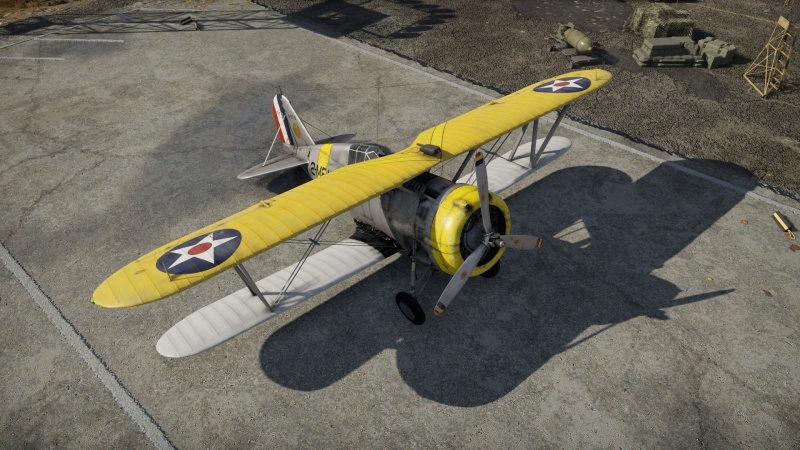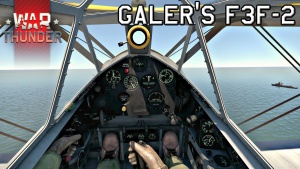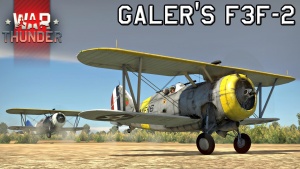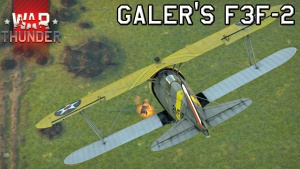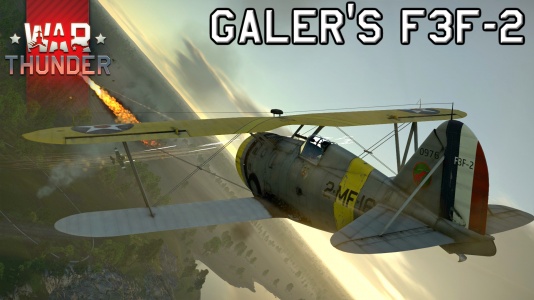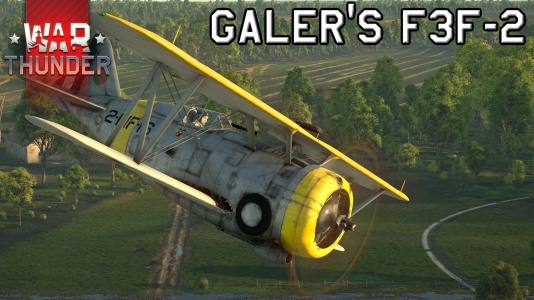Galer's F3F-2
| This page is about the premium American fighter Galer's F3F-2. For the regular version, see F3F-2. |
Contents
Description
Bob Galer was a naval aviator in the USMC. While flying in his F3F-2 for a landing on the USS Saratoga, a mishap occurred and his F3F-2 was ditched into the ocean. Galer would later become a double ace during the battle of Guadalcanal and would survive the war. He also served in Korea until he retired in the late 1950s. Galer was shot down four times and managed to survive every time. Galer’s F3F-2, still resting at the bottom of the Pacific, was discovered by an American submersible in 1988 and recovered three years later. His plane is currently on display at the National Naval Aviation Museum.
Introduced as a premium fighter in Update 1.69 "Regia Aeronautica", Galer's F3F-2 is a special version of the F3F-2. It mainly differs in the livery and higher reward modifiers compared to the regular F3F-2. Fitted with the 950 hp version of the Wright R-1820 Cyclone, the F3F is a relatively quick bi-plane and can reach an astounding ~506 mph (810 km/h) before overspeeding. Its armament consists of one 12.7 mm and one 7.62 mm machine gun mounted in the nose. Although lacklustre, the F3F-2’s performance more than makes up for it.
General info
Flight performance
The F3F-2 is a highly manoeuvrable aircraft as would be expected from its biplane configuration, this allows it to competitively turn with majority of the enemy aircraft that it encounters, the energy retention is good at lower speeds (<250 km/h), but at higher speeds the F3F-2 will lose energy quickly when in a hard turn, problems will be found when facing higher BR monoplane fighters which will have a considerably superior top speed this can cause problems due to the slower speed of the F3F.
Despite the slower speed of the F3F-2 it does have good early acceleration (0-240 km/h) and will usually be one of the first aircraft in the air at the start of the match thanks to its 210 m needed takeoff distance, the 16 m/s climb rate will also allow for the F3F-2 to have an altitude against majority of the enemy fighters that it will face.
| Characteristics | Max Speed (km/h at 4,300 m) |
Max altitude (metres) |
Turn time (seconds) |
Rate of climb (metres/second) |
Take-off run (metres) | |||
|---|---|---|---|---|---|---|---|---|
| AB | RB | AB | RB | AB | RB | |||
| Stock | 407 | 392 | 13.5 | 13.9 | 11.9 | 11.9 | 57 | |
| Upgraded | 444 | 425 | 12.8 | 13.0 | 19.9 | 15.6 | ||
Details
| Features | ||||
|---|---|---|---|---|
| Combat flaps | Take-off flaps | Landing flaps | Air brakes | Arrestor gear |
| X | X | X | X | ✓ |
| Limits | ||||||
|---|---|---|---|---|---|---|
| Wings (km/h) | Gear (km/h) | Flaps (km/h) | Max Static G | |||
| Combat | Take-off | Landing | + | - | ||
| N/A | N/A | N/A | ~13 | ~6 | ||
| Optimal velocities (km/h) | |||
|---|---|---|---|
| Ailerons | Rudder | Elevators | Radiator |
| < 220 | < 280 | < 420 | > 250 |
| Compressor (RB/SB) | ||
|---|---|---|
| Setting 1 | ||
| Optimal altitude | 100% Engine power | WEP Engine power |
| 1,600 m | 850 hp | 952 hp |
| Setting 2 | ||
| Optimal altitude | 100% Engine power | WEP Engine power |
| 4,214 m | 750 hp | 840 hp |
Survivability and armour
- 8.5 mm steel boxes in the rear fuselage
- Critical components located in front of aircraft (fuel, pilot, engine, controls)
- Two self-sealing fuel tanks located in the fuselage
Modifications and economy
Armaments
Offensive armament
Galer's F3F-2 is armed with:
- 1 x 12.7 mm M2 Browning machine gun, nose-mounted (200 rpg)
- 1 x 7.62 mm Browning machine gun, nose-mounted (500 rpg)
Suspended armament
Galer's F3F-2 can be outfitted with the following ordnance:
- Without load
- 2 x 100 lb AN-M30A1 bombs (200 lb total)
Usage in battles
The F3F is first and foremost a fighter aircraft, this is a role in which it thrives with its brilliant manoeuvrability allowing it to deal with majority of enemy aircraft in a turn fight, trying to get an enemy aircraft to turn with you will be the best way to engage and win a fight, if the enemy is a monoplane they will usually have worse performance at slower speeds, so making them turn and lose energy is a good way to gain an advantage with your superior slow speed performance, if the enemy aircraft is also a biplane your main focus should be preventing them from getting guns onto your aircraft, if you can gain a turning advantage you should move into position and attempt to down the enemy aircraft, your two guns can end up putting lots of rounds into an enemy, but a hit to any critical component such as the pilot or engine will either end the fight or put it strongly in your favour. It is best to avoid "head on" engagements with enemy aircraft, as the engine on the F3F has a large frontal profile (Radial engine) along with the engine front being exposed, this makes the engine being hit a common occurrence and without your engine survival is unlikely.
The F3F will commonly come across aircraft with superior top speed, such as many of the early Bf 109 variants (A,B-1,E-1 & F-1), these aircraft will usually attempt to use a "boom & zoom" attack style against your aircraft, the best you can do is to keep a good amount of energy and be ready to evade when the commit to an attack run, if you can evade them for long enough you will hopefully receive some help from some of your other team members or you might be able to make the enemy try and commit to a turn fight where you should have an advantage and be able to critically damage or down their aircraft.
As for using the F3F for close air support (CAS) you will have a few possibilities, the most popular choice will be to take the two 100 lb bombs (AN-M30A1), these only contain 24.5 kg of explosive mass so you will need to land them very close to the intended target to do any meaningful damage. A second option is to use your .50 cal (12.7 mm) Browning M2 machine gun to destroy ground targets, all belts for this gun have 26 mm of penetration, although the ground targets belts are best as they contain more AP rounds, these will be able to go through SPAA (Self Propelled Anti Aircraft) vehicles as well as some light & medium tanks, firing for the upper armour or side armour on enemy vehicles will usually prove to be the most effective way of going through enemy armour.
It is recommended not to hold the brakes on landing, as the F3F will likely flip over, it is best to tap the breaks on and off to avoid this occurring.
Manual Engine Control
| MEC elements | ||||||
|---|---|---|---|---|---|---|
| Mixer | Pitch | Radiator | Supercharger | Turbocharger | ||
| Oil | Water | Type | ||||
| Controllable | Controllable Not auto controlled |
Not controllable Not auto controlled |
Not controllable Not auto controlled |
Separate | Controllable 2 gears |
Not controllable |
Pros and cons
Pros:
- Excellent manoeuvrability
- Very low stalling speed
- Controls are extremely responsive
- Powerful .50 cal (12.7 mm) machine gun
- Climb rate is competitive against aircraft of similar BR
- Two 100 lb bombs for attacking ground targets
Cons:
- Small primary armament which can be inadequate against large targets
- Low ammunition count for the 12.7 mm machine gun
- Can flip over the nose when landing if the brakes are held down too long
- The 100 lb bombs have a small explosive warhead and therefore aren't very effective against ground targets
History
Galer’s F3F-2 is the F3F-2 flown by then-First-Lieutenant Bob Galer, USMC, who was forced to bail out during landing operations. Lt. Galer would become a double-ace during WWII, having survived being shot down four times, received the Medal of Honor for heroism at Guadalcanal, and retired as a brigadier general. Galer’s F3F-2 was recovered in 1988 from the bottom of the Pacific Ocean; following a reunion with the aircraft’s former pilot, the plane is now on display at the National Naval Aviation Museum of the United States.
Robert ‘Bob’ E. Galer was a naval aviator in the United States navy, having joined the navy in 1936. While assigned to Marine Fighting Squadron two (VMF-2), he was attempting a landing on the USS Saratoga (CV-3) when his F3F-2 failed; as a result, he was forced to ditch the aircraft into the ocean. He was later stationed in Hawaii for most of 1941, promoted to the rank of captain. He was stationed with VMF-211 when the Japanese attacked Pearl Harbour on December 7th, 1941.
Galer was given command of VMF-224 in May of 1942 and later fought at the Battle of Guadalcanal; it was during this conflict that he shot down 11 enemy aircraft, becoming a double-ace and receiving the Medal of Honor for his actions. Galer was also awarded the British Distinguished Flying Cross, a rare occurrence for the time. Afterwards, Galer served as assistant operations officer at Naval Air Station (NAS) Miramar; he was not permitted to fly in combat due to his status as a medal-of-honor recipient, exacerbated by the fact that he had been shot down three times already.
By 1945, Galer had obtained the rank of Lieutenant Colonel. Staying with the navy, he was sent to Korea in 1952 as a full Colonel, received a Gold Star (in lieu of a second Distinguished Flying medal) for leading an aerial attack on Pyongyang. He was shot down once more in August of 1952 after being hit by anti-aircraft fire. Galer returned to the United States after the end of the Korean conflict and retired in 1957 at the rank of Brigadier-General; he later served as vice-president of Ling-Temco-Vought (LTV) later as an executive with Bright & Co. He would be reunited with his former F3F-2 in 1988 after the aircraft was recovered from the depths of the Pacific Ocean. Brigadier General Galer died of a stroke on 27 June 2005 in Dallas, Texas; he is survived by his wife, four children and six grandchildren. Galer’s F3F-2 is now on display at the National Naval Aviation Museum, restored to its markings when flown by Galer in 1940.
Media
- Skins
- Images
- Videos
See also
- F3F-2 - the normal tech tree version of the F3F
- Zhukovsky's I-153-M62 - similar Soviet biplane
External links
Paste links to sources and external resources, such as:
- topic on the official game forum;
- other literature.
| Grumman Aircraft Engineering Corporation | |
|---|---|
| Aircraft | |
| Fighters | |
| F3F | F3F-2 · Galer's F3F-2 |
| F4F Wildcat | F4F-3 · F4F-4 |
| XF5F Skyrocket | XF5F · XP-50 |
| F6F Hellcat | F6F-5 · F6F-5N |
| F7F Tigercat | F7F-1 · F7F-3 |
| F8F Bearcat | F8F-1 · F8F-1B |
| Jet Fighters | |
| F9F Panther/Cougar | F9F-2 · F9F-5 · F9F-8 |
| F-11 Tiger | F11F-1 |
| F-14 Tomcat | F-14A Early · F-14B |
| Jet Strike Aircraft | |
| A-6 Intruder | A-6E TRAM |
| Bombers | TBF-1C |
| Export | ▄Martlet Mk IV · ▄F6F-5 · ▄F6F-5N · ▄F8F-1B · ▄Avenger Mk II · ▄Hellcat Mk II |
| ▄F-14A IRIAF | |
| Naval Vehicles | |
| Patrol Gunboat Hydrofoil (PGH) | USS Flagstaff |
| USA fighters | |
|---|---|
| P-26 Peashooter | P-26A-33 · P-26A-34 · P-26A-34 M2 · P-26B-35 |
| P-36 Hawk | P-36A · Rasmussen's P-36A · P-36C · ○P-36C · P-36G |
| P-39 Airacobra | P-400 · P-39N-0 · P-39Q-5 |
| P-40 | P-40C · P-40E-1 · P-40E-1 TD · P-40F-10 |
| P-43 Lancer | P-43A-1 |
| P-47 Thunderbolt | P-47D-22-RE · P-47D-25 · P-47D-28 · P-47M-1-RE · ⋠P-47M-1-RE · P-47N-15 |
| P-51 Mustang | P-51 · P-51A (Thunder League) · P-51C-10 · P-51D-5 · P-51D-10 · P-51D-20-NA · P-51D-30 · P-51H-5-NA |
| P-63 Kingcobra | P-63A-5 · P-63A-10 · P-63C-5 · ␠Kingcobra |
| Prototypes | XP-55 |
| F2A Buffalo | F2A-1 · Thach's F2A-1 · F2A-3 |
| BF2C | BF2C-1 |
| F3F | F3F-2 · Galer's F3F-2 |
| F4F Wildcat | F4F-3 · F4F-4 |
| F4U Corsair | F4U-1A · F4U-1A (USMC) · F4U-1D · F4U-1C · F4U-4 · F4U-4B · F4U-4B VMF-214 · F2G-1 |
| F6F Hellcat | F6F-5 · F6F-5N |
| F8F Bearcat | F8F-1 · F8F-1B |
| Other countries | ▃Ki-43-II · ▃Ki-61-Ib · ▃A6M2 · ▃Bf 109 F-4 · ▃Fw 190 A-8 · ▃Spitfire LF Mk IXc |
| USA premium aircraft | |
|---|---|
| Fighters | Thach's F2A-1 · Galer's F3F-2 · F2G-1 · F4U-4B VMF-214 · P-26A-34 · Rasmussen's P-36A · P-40C · P-43A-1 |
| P-47M-1-RE · ⋠P-47M-1-RE · P-51A · P-51D-10 · P-51D-20-NA · ␠Kingcobra · XP-55 | |
| ▃A6M2 · ▃Ki-43-II · ▃Ki-61-Ib · ▃Bf 109 F-4 · ▃Fw 190 A-8 · ▃Spitfire LF Mk IXc | |
| Twin-engine fighters | XP-38G · Bong's P-38J-15 · P-38K · YP-38 · P-61A-11 · XF5F · XP-50 · F7F-3 |
| Jet fighters | P-59A · F-86F-35 · F-89B · F-89D · F-4S Phantom II · F-5C · F-20A |
| Strike aircraft | A-1H · A2D-1 · AU-1 · XA-38 · AV-8A · AV-8B (NA) · A-6E TRAM · A-10A |
| Bombers | A-26C-45DT · B-10B · BTD-1 · PBM-3 "Mariner" · PBM-5A "Mariner" · PV-2D |



